|
New Year’s Resolutions…
1) I will avoid any new novel which comes with the assurance that it will appeal to fans of Gone Girl and Girl on a Train.
2) I will probably avoid any new novel with Girl in the title.
3) I will avoid any book which comes hyped with a strapline beginning How far would you go…
4) I will continue to promote, enthusiastically and uncritically, any and all Scandinavian crime fiction despite the fact that the entire population of Sweden has by now written a book.
5) I will attempt to discover why I have been blacklisted and am no longer invited to the annual Publishers’ Publicity Circle and the Penguin Crime parties. I am already well aware of why I am on the blacklists of three publishers (so far).
6) I will try – I really will – to understand why some publishers think that producing an eBook version of a new novel six months before the real book is a good idea.
…which didn’t last long.
Already my New Year’s Resolution #2 has been broken as I have been unable to avoid the hype surrounding a new psychological thriller described as “dazzling” and “pitch-perfect” by Lee Child: The Girl Before by J.P. Delaney, published by Quercus.

Already the subject of frenzied international publishing deals and interest from Hollywood, the name ‘J. P. Delaney’ hides the identity (possibly for tax reasons given all those deals) of an author who is, it is said a writer of best-selling fiction ‘under other names’.
I have no idea who is behind the Delaney name but I suspect it is not American debutant Rena Olsen, whose first novel was published last August with the very same title.


It Was Twenty Years Ago Today (thereabouts)
As looking back on 2016 is such a depressing prospect in so many ways, I have taken refuge in history and reviewed what I was reading as 1996 ended, when I was commissioned to write two ‘Crime Guide’ columns for the Daily Telegraph in January and February 1997.
My first assignment was a slew of anthologies, noteworthy as the previous years had seen a dearth of crime fiction collections and it seemed that a revival was underway. Two were edited by Peter Haining – The Orion Book of Murder and Pulp Frictions: Hardboiled Stories [Souvenir Press]. Haining’s Orion collection scored highly for including ‘more famous names than a box of liqueurs’ including Holmes, Raffles, Templar, Spade, Morse and Wexford as well as Christiana Brand’s lovely Inspector Cockerill and Joyce Porter’s odious Chief Inspector Dover. His Pulp Frictions scored for having stories by Chandler, Hammett, Goodis and Thompson as well as Stephen King and the wonderful Sam Fuller – better known as a film director.
Mike Ashley’s Classical Whodunnits [Robinson] compiled a collection of mysteries set in Ancient Greece and Rome, many of them originals, which did not disappoint. Particularly noteworthy were contributions from Anthony Price and, of course, the ‘queen of the toga-and-dagger private eyes’ Lindsey Davis.
Less convincing was The Killing Spirit; An Anthology of Assassins [Canongate] edited by American Jay Hopler which I felt read like ‘an unfinished PhD thesis’ – as it very well may have been. It was noteworthy for extracts from Highsmith and Greene and stories from Lawrence Block and Andrew Vachss (who has a dog as assassin), but lost marks for forgetting the famous real assassins who have appeared in fiction (eg: John Wilkes Booth and Lee Harvey Oswald) and indeed The Jackal (as in Day Of ) and the best assassin who-never-was, the hero of Rogue Male.
In my regular round-up of crime novels, some famous and still familiar names all produced highly-recommended work, including Ian Rankin with Black & Blue, Michael Connelly with Trunk Music, Ruth Dudley Edwards with Murder In A Cathedral, and Val McDermid with her fifth Lindsay Gordon mystery for Women’s Press, Booked for Murder, which I described as ‘funny and scary by turns, always sharp’ which could be said of Val’s barnstorming performance as the captain of the St Hilda’s team which won the 2016 Christmas University Challenge last month.
In that first fiction Crime Guide of 1997 I also praised two novels of which I now, sadly, have little memory. At the time though, I rated Sandra Nichols Found Dead by the great George V. Higgins (who was to die aged only sixty two years later) on the basis that ‘Higgins has an ear for dialogue musicians would envy’ and though I cannot remember that specific book, I hold to that sentiment. The other was, I believe, to be the last crime novel written by ‘Jack Curtis’ a pen-name used by the poet (and author of westerns) David Harsant. I was much taken with The Confessor which I described as ‘A cracking thriller wringing new twists from the “serial killer hunted by troubled cop” scenario. Nails you to the page.’
Coming Up
Twenty years on from being nailed to the page by a serial killer thriller, it seems that that particular sub-genre has lost none of its appeal, at least to debut authors wanting to make a splash. This month sees two – Perfect Remains by Helen Fields [Avon] and Rattle by Fiona Cummins [Pan] – and in February, the Trapeze imprint of Orion publishes Ragdoll by Daniel Cole which involves a certain amount of – how to put this? – stitching, which brought to mind a particularly gruesome episode from Hannibal the television series, though I admit that doesn’t narrow it down.
 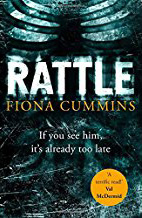 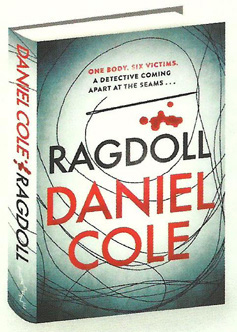
Seeking a more gentle introduction to the New Year, I am currently enjoying an excellent spy thriller, Deep Blue by Alan Judd, which has just been slipped out as a paperback original by Simon & Schuster.
It is a disgracefully long time since I read a novel by Alan Judd and am shocked to find that he has written other spy stories featuring Charles Thoroughgood of MI6 (the central character in Deep Blue), who first appeared, if memory serves, in Judd’s excellent first novel of modern military life, A Breed of Heroes way back in 1981.
I can see I have some catching up to do, as I have with the latest Inspector Sloan novel from my old chumette Catherine Aird in her much-loved ‘Calleshire Chronicles’ series, Calleshire being an invented English county which on certain days bears a striking resemblance to Kent.
Learning Curve was actually published last September by Allison & Busby and I am considerably ‘behind the curve’ on this one, though I will certainly have read it before the paperback edition appears in March.
My immediate priority, however, is the new thriller from Mike Nicol, Agents of the State, coming in February from Old Street Publishing.
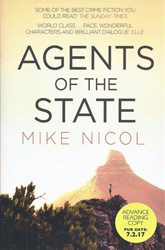
Mike Nicol is one of the leading lights in South African crime fiction at the moment. Some years ago, I identified the leading male South African crime writers (there are a growing number of excellent female ones too) for an American audience by making ‘local’ comparisons. Deon Meyer was ‘the South African Michael Connelly’, Roger Smith was ‘like a South African Elmore Leonard’ and Mike Nicol was ‘the South African Robert Crais’. Such comparisons are crude and probably transient but I hope they gave some impression of the quality of crime-writing coming out of the southern hemisphere these days.
Air on a G-String
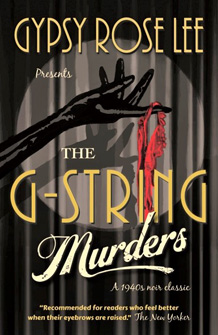
Scottish publisher Saraband has clearly made a New Year’s resolution not to be typecast when it comes to their crime fiction output. Their crime imprint Contraband hit the headlines last year with the fantastic His Bloody Project which was shortlisted for the 2016 Man Booker prize (though bizarrely not even long-listed for the Crime Writers’ Gold Dagger) and in March the imprint will certainly get noticed with the reissue of a famous piece of American pulp fiction.
The G-String Murders by Gypsy Rose Lee, the vaudeville dancer and striptease artiste (whose memoirs later formed the basis of the 1962 film Gypsy starring Natalie Wood), caused quite a stir when it first appeared in 1941 and within a year it was said to have outsold Dashiell Hammett’s The Thin Man.
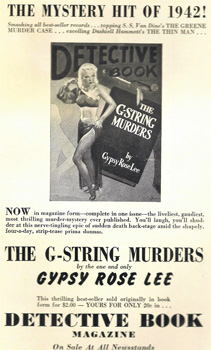
When the novel was published in paperback in the UK in the 1950s, the title was clearly thought a little too risqué for British readers and so was softened to The Striptease Murders although the publishers could not resist, just to make things clear, adding the strap-line: Strangled…with their own G strings.
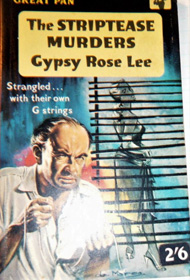
Whilst wishing Contraband/Saraband every success with this venture, I suspect they are not putting the champagne on ice for another Man Booker nomination.
|
|
Classical Studies
Few of the regular readers of this column will need reminding that the Via Appia was begun in 312 BC by the magistrate Appius Claudius Caecus, but how often has that most famous of Roman roads featured in not one but two thrillers read in succession over a Christmas holiday?
At first sight, the cover of Francis Beeding’s The Six Proud Walkers suggests that it might be a western, with the horseman illustrated seemingly in dramatic cowboy pose. On closer examination, however, the background to the horseman is not a sierra or a mesa from New Mexico or Arizona, but a scene from antiquity and the horseman is not signalling an imminent stampede or attack by hostile Indians, but rather (as the story unfolds) calling for help as he attempts to escape (on horseback on the Appian Way) from a sinister conspiracy run by a prototype SPECTRE-like organisation.
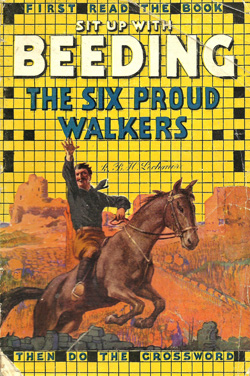
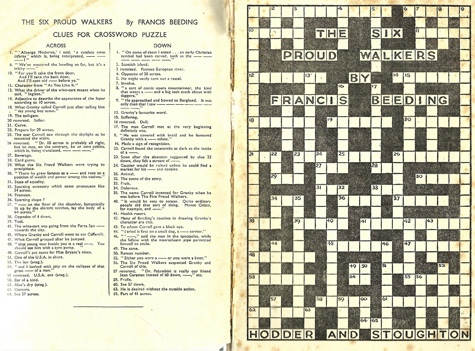
Admittedly my copy of The Six Proud Walkers is an unusual one, being the 1932 (?) ‘Ninepenny’ Hodder & Stoughton paperback edition of the 1928 novel, which comes complete with a crossword puzzle and the exhortation First read the book, then do the crossword.
I think this may well be the first Francis Beeding thriller to feature British spymaster-hero Colonel Alistair Granby who was to go on to star in more than a dozen Beeding thrillers through the 1930s and whose favourite advice to his agents or minions was always ‘Steady the Buffs!’ whenever danger threatened or a heaving female bosom loomed in to view.
Although very much a forgotten name today, Francis Beeding’s thrillers were big sellers in the inter-war period. So well-known were they, even by 1932, that the surname Beeding became a brand in its own right and the books were marketed as ‘Sit Up With Beeding’ after a reviewer claimed that one early helter-skelter adventure had made him sit up all night to finish it.
In fact there were two authors behind the Francis Beeding brand, John Palmer (1898-1944) and Hilary St George Saunders (1898-1951) who met as undergraduates at Oxford and both went on to work for the League of Nations, their day jobs providing many of their plots and backgrounds which usually involved international diplomatic skullduggery and European locations.
As far as I am aware, no attempt has been made to revive the Granby thrillers of Francis Beeding, although the detective stories they also wrote (they were quite prolific) have been reissued with some success and acclaim – notably Death Walks in Eastrepps and The Norwich Victims. To be fair, the Granby thrillers are very much of a muchness, the standard formula being that an innocent young chap (usually a recent Oxbridge graduate) travelling abroad finds himself accidentally caught up in a fiendish plot to disrupt the peace of Europe masterminded by a character called Caramac (shades of Ernst Stavro Blofeld). Our young hero invariably witnesses a violent death, is captured, tied up but then escapes and by happy coincidence makes contact with Colonel Granby, conveniently on holiday in the same location, who takes charge. There is invariably a young female love interest, often a fiancée, who has to be protected but is also easily available to be captured (tied up, etc.) by the baddies. There are lots of chases and escapes by every conceivable form of transport and in Proud Walkers the innocent young hero is shocked at the amount of money Granby is spending on taxis to pursue (or avoid) the bad guys around Rome and its suburbs.
Despite their formulaic nature, the thrillers of ‘Francis Beeding’ do not deserve to be forgotten. Although in many ways derivative of John Buchan’s ‘shockers’, they have clearly moved beyond Buchan’s imperialist world view and take a more cynical approach to contemporary European power politics. They also show a realistic approach to standard thriller conventions (gunfights, pharmaceuticals and so forth) and do have a terrific sense of pace; all attributes which, it could be argued, were to be used and refined by Ambler and Fleming.
Above all, it should be remembered that in what is now referred to as the ‘Golden Age’ of the English detective novel, the real bestsellers were the immensely popular thrillers of Edgar Wallace, Sapper, Oppenheim and Francis “Sit Up With” Beeding. I suspect many members of the elite Detection Club would have given their eye-teeth for a fraction of the sales’ figures of those writers whose work (as Dorothy L. Sayers said) was ‘reduced to the thriller class’.
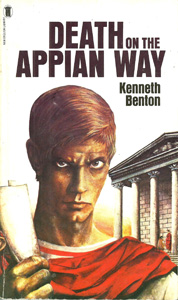 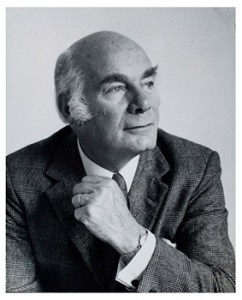
My other encounter along the Appian Way this Christmas was a professional one, though no less enjoyable for that, as I am in the process of editing the forthcoming Ostara edition of Kenneth Benton’s Death on the Appian Way.
Benton’s 1974 novel is an examination political chicanery in the last decade of the Roman Republic rather than a traditional murder mystery (though not short on violent deaths), which will appeal to fans of Robert Harris’ ‘Cicero’ trilogy. Indeed Cicero plays a key role in the novel, as does the notorious ‘socialite’ Clodia, sister (and possible lover) of the street-fighting politician Clodius Pulcher. Set between the years 63-52 BC, with the power struggle between Caesar and Pompey looming and based on historical incidents and trial proceedings, Death on the Appian Way is a seriously neglected historical novel by an author who made his name with contemporary political thrillers in the 1960s and 1970s.
Kenneth Benton (1909-1999) was one of the most interesting and yet probably most unsung Chairmen of the Crime Writers’ Association, succeeding Dick Francis in that post in 1974. Benton took up thriller writing only on retirement from a thirty-year career as an MI6 officer, serving initially in Vienna in 1937, then in Riga, Madrid and Rome during World War II and after the war in South America, where several of his spy novels were set. For a time, between 1941 and 1943, his immediate boss in the ‘Iberian section’ of MI6 was a certain Kim Philby.
Benton’s series hero in his spy novels was Peter Craig and his fictional career, as well as the life of his creator, is expertly covered on the website created by Dan Benton, the author’s grandson, at http://craig-thrillers.com/.
TV Times
The return of Sherlock to the small screen has sparked a debate in certain circles about crime dramas on television. At the ‘easy listening’ end of the viewing spectrum, Midsomer Murders, Death in Paradise and, even though scheduled in the early afternoon, Father Brown all have dedicated audiences and for some reason Jonathan Creek seems to have almost iconic status.
Being somewhat jaundiced these days and in need of a good shock to the system after the lethargy induced by Christmas, my personal viewing destination this month will be the new series of Paul Abbott’s wonderfully anarchic No Offence with its brilliant ensemble (mostly female) cast.
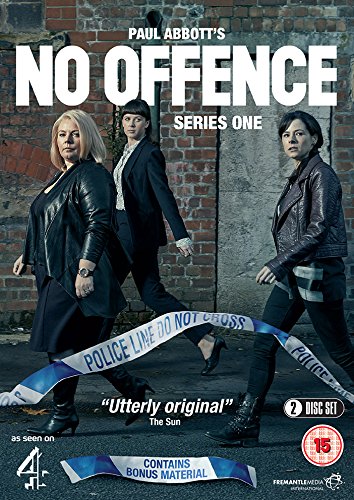
The new series will certainly keep me going until – if the rumours are true – a third series of the Italian crime drama Gomorrah is completed. Based on Roberto Saviano’s trail-blazing book about family-run crime businesses in the bits of Naples most tourists (hopefully) don’t see, there was a film of the book in 2008 but the concept was so strong it was developed as a television saga in 2014.

The production values, acting and direction are all superb and the best way to describe this epic to the uninitiated is probably that it is like Game of Thrones but with Vespas instead of dragons and automatic weapons instead of swords.
RebusFest
News reaches me of plans for the first RebusFest to be held in Edinburgh (naturally) June 30th to July 2nd to celebrate the thirtieth anniversary of Inspector John rebus as created by Ian Rankin. The week-end will include walking-tours, music events, food and, of course drink.
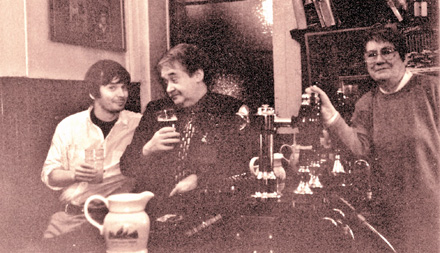
The event has been a long time in the planning and I was one of the first human guinea pigs to be taken on a guided tour of Rebus country by Ian Rankin in his armour-plated Volvo estate back in 1997. That private tour twenty years ago,as well as many during RebusFest will I suspect, ended in the famous Oxford Bar.
Chianti Crime
I am delighted to hear that the civic authorities of the famous Tuscan town of Pisa are already rehearsing the pageant planned to mark the opening of this year’s Chianti Crime Festival.
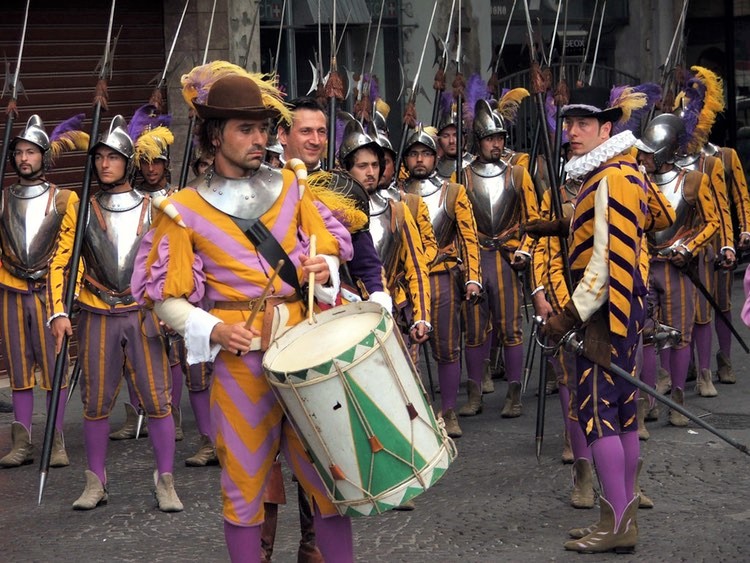
There is far more to Pisa than its famous leaning tower (sometimes referred to as ‘that bloody tower’ by the locals) and when the Crime Festival, sponsored so generously by the Chianti producers of Tuscany, arrives in June it could become famous for its leaning crime writers. I am told that tickets for the Festival are already quite rare.
Ciao!
The Ripster.
|